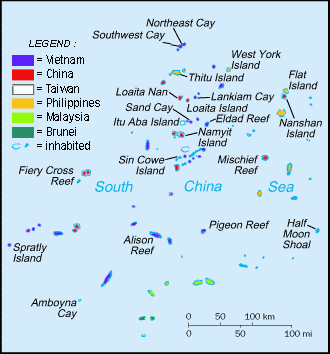Mischief Reef
Mischief Reef or Meiji Reef (Tagalog: Panganiban; Chinese: 美济礁; pinyin: Meiji Jiao; Vietnamese: Đá Vành Khăn) is a reef in the Spratly Islands in the South China Sea. Some rocks above water at low tide. It has a lagoon.[1] This reef is also being claimed by the Philippines and Vietnam.
Chinese Occupation
Philippines largely controlled this feature before. Filipino fishermen also used to fish in this reef.[2][3][4] However in 1994, PRC was able to build initial structures on stilts here while Philippine Navy is not patrolling the area due to a monsoon season. Being just 130 miles (209 km) away from Palawan, well inside the Philippines' EEZ, Philippines immediately protested this action. However, China rejected it and stressed that the structures are shelter for fishermen. In 1999, another wave of protests from Manila occurred when China added more structures in Mischief Reef which resemble military installations than shelter for fishermen.[4]
The Philippines dubbed China's actions in South China Sea as a part of China's "creeping invasion." For instance, China is also reported to have planted buoys in Sabina Shoal, a much closer reef from Palawan which is just 70 miles (113 km) away. Philippines claimed China has a well-rehearsed routine when laying claim to a new reef: first it put down buoys, then it build concrete markers. Temporary wooden or bamboo shelters follow, and if China is still not challenged, the permanent military forts go up. The Philippines tries to blow up the buoys or the markers before China has time to build larger structures.[4]
This incident have severed the relations of China and the Philippines in 1999 to the point the two countries are likely to go to a war. Philippines' decision not to blow up the Chinese-structures in Mischief Reef have stopped the escalation of the dispute. Philippines claims that China has always been prepared for battle when opposed, evident in China's defence of reefs from Vietnam in the 1988 Johnson South Reef Skirmish which resulted to more than 70 Vietnamese deaths.[4] Philippines decided not to attack since it could have led the two countries in a war. Philippines, with inferior military strength compared to China, would likely have lost most of its occupied Spratly islands if that happened.
Sea Also
References
- ^ "Digital Gazetter of Spratly Islands". Retrieved 2008-03-22.
- ^ Bordadora, Norman (2008-03-11). "Lawmaker fears RP will lose out in race for Spratlys oil". Philippine Daily Inquirer. Manila. Retrieved 2008-07-30.
{{cite journal}}: Check date values in:|date=(help); Unknown parameter|coauthors=ignored (|author=suggested) (help) - ^ Burgonio, TJ (2008-03-10). "Palace should explain Spratlys seismic survey--Golez". Philippine Daily Inquirer. Manila. Retrieved 2008-07-30.
{{cite journal}}: Check date values in:|date=(help) - ^ a b c d McCarthy, Terry (1999-03-08). "Reef Wars". Time Asia. 153 (9). Puerto Princessa, Palawan. Retrieved 2008-03-22.
{{cite journal}}: Check date values in:|date=(help)

